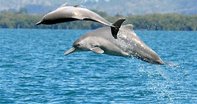
Name : Humpback Dolphin
Scientific Name : Sousa chinensis
Class : Mammalia
Family : Delphinidae
Order : Cetacea
Shape : The young have the same shape as young Bottlenose Dolphins. The animal's snout is rather slender. There are between 32 and 37 small cone-shaped teeth on each side of the upper jaw, and 32 to 34 on each side of the lower jaw.
Fins : In the populations of western Indonesia that, in aging, a greasy tissue resembling a bump in front of the dorsal fin grows on the back. By the caudal fin, there is a careen on the ventral and dorsal sides. The dorsal fin is triangular and located in the middle of the back. The pectorals are short and paddle-shaped, and the caudal fin is well developed and has a median notch.
Length : It measures between 2 and 3.2 metres and newborns between 90 and 110 cm.
Weight : Its average weight is between 85 and 139 kg and newborn's about 25 kg.
Colour : Colouring varies with age and geographic distribution, ranging from ivory-white with a white stomach to dark grey.
Diet : This dolphin feeds on various species of fish, molluscs, and crustaceans, which it catches in shallow waters (rocky areas, in proximity to reefs, and often among mangroves).
Population : This species is plentiful in the waters in which it lives.
Habits : When this dolphin emerges in order to breathe, the snout alone, or sometimes the entire head, first appears above water. The species is generally gregarious and moves in groups of six to nine individuals, and sometimes up to 20.
Distribution : This is a coastal cetacean that spends most of its time in lagoons, estuaries, and mangrove swamps. It is rarely seen farther than 20 km.